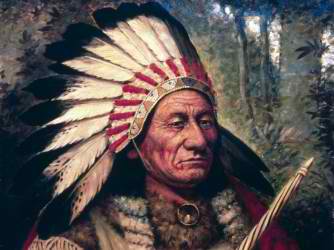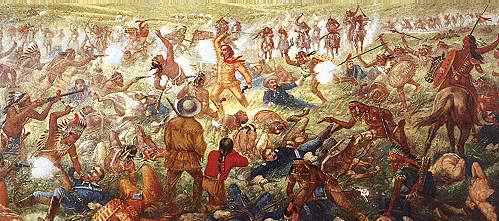Sitting Bull was one of the most renowned chiefs during the time where Native Americans were fighting for their rights of settlement. With many nations trying to claim their lands, Sitting Bull Indian was one of those who led his people to a good fight. Looking through Sitting Bull timeline, it can be seen that he has been into many wars, big and small. His chieftainship is often one of the most recalled when looking through the history of the Native Americans. In every enumeration of effective chiefs that ever rules, his name is always there, beaming with pride.

Sitting Bull Indian’s Early Life
Sitting Bull Indian was born on 1831. His place of birth was around the area of the Grand River, Dakota. He was said to be originally named as Jumping Badger. He was born in the tribe of Sioux, specifically in the Hunkpapa territory. At a young age, he was perceived as weak and slow, giving doubts as to whether he can follow the footstep of his father. He started his war experience at an early age, him being only 14. This first exposure to a war has cemented his potential of being a good warrior, and even a leader, in the future. This also led to him finally being named like his father.Upon returning from the fight, his performance was celebrated and he was anointed with a new name, Thathanka Iyothanka, which meant ” Buffalo Bull Sits Down,” which was shortened into Sitting Bull later on.
Chief Sitting Bull Indian’s Role in the War

All throughout his life, Chief Sitting Bull Indian has seen how his tribe has been strongly oppressed by the white Americans. They were in a constant battle in order to protect their lands. He was chosen to lead the Strong heart Society and June 1863 marked his first real combat with the American troops. It was during a fight that followed the “Minnesota Massacre.”
Sitting Bull Indian became an official chief int he year 1866. His trusted right hand during that time was Crazy Horse, who became his vice-chief. He was made a chief of the entire Sioux tribe, and not just into a single division. He was a leader of courage and wisdom, making him worthy of being the leader of the whole nation.
In 1868, with the nation already being under the leadership of Sitting Bull, it entered into a peace agreement with the U.S. Government. However, many said that it was a treaty signed by Red Cloud. This conclusion was derived from the accounts which said that Sitting Bull was highly against treaties. He had least trust to the white Americans, and as much as possible, he did not want to cross paths and interact with them. This was called the Second Treaty of Fort Lamarie. This agreement was supposed to secure the territory for the use of the entire Sioux nation.Unfortunately, the treaty did not exactly last long once it has been identified that the territory given to them was abundant with gold, especially the Black Hills, in 1970. With this, white Americans’ interest towards the land redeveloped. Many went over the boundaries despite the existence of the treaty in order to get hold of the gold.
This further intensified Chief Sitting Bull Indian’s hate towards treaties. He influenced other areas such as Cheyenne and Arapaho to feel the same towards treaties. With that, they entered into a fight with the troops of General George Crook. The strength of the tribes has reduced the army to retreat in Bighorn River. Unfortunately, it was during this time that Sitting Bull Indian’s predictions started running. One of the many interesting facts about Sitting Bull Indian was that aside from a warrior, Sitting bull was also prophetic.
In his prophecy, many of the soldiers will die as the war reaches the area of Bighorn. Many were skeptical, although there were also those who strongly believed in his vision. Nevertheless, this did not stop the battle from happening. It went down to history as the Battle of the Little Bighorn. True to his vision, the entire troop under the army of Colonel George Armstrong Custer died during the battle.
Unfortunately, it has been a short-lived success for the Sioux. They did not get to revel in their victory that long as the white Americans became more aggressive in their revenge. In the end, Chief Sitting Bull Indian was forced to run to Canada. During 1881, he went back and surrendered himself to the United States.Because of his high contribution, he became a prisoner of war. 2 years later, he was freed to return to Standing Rock Reservation and there he resumed his responsibility of protecting their lands from the claims of the American government.With the spread of the Ghost Dance as a religion, he was again seized, and this time, he was killed.
